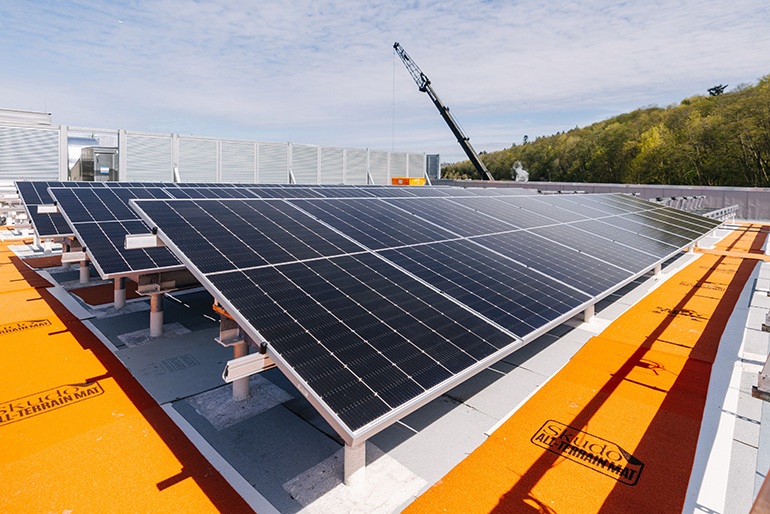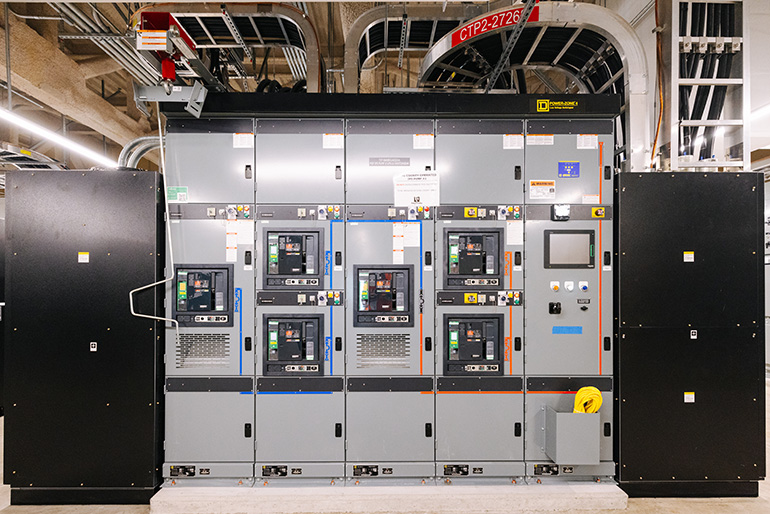Fully charged to protect Puget Sound: King County team delivers on Executive Constantine’s emergency declaration to provide West Point Treatment Plant with high-quality power
Summary
September 13, 2024 – King County’s Wastewater Treatment Division delivered on an emergency declaration signed by Executive Constantine to provide West Point Treatment Plant with onsite batteries for high-quality power to Puget Sound’s largest wastewater treatment facility.
News
King County Executive Dow Constantine today congratulated a project team for completing construction of a unique high-voltage battery system that provides stable power to West Point Treatment Plant, delivering on his emergency declaration to protect Puget Sound and prepare the facility for climate impacts.
Within two years, King County’s Wastewater Treatment Division demolished an older building and built a 24,000-square-foot structure that contains more than 48,000 battery cells. The onsite power system prevents split-second voltage sags from the inbound power lines from shutting down the plant’s critical operating pumps. It is the first project of its kind in the United States.
“Three years ago, I promised to ensure frontline operators would have the steady, high-quality power they need to uphold our commitment as trusted stewards of Puget Sound, and our project team has now delivered real results for this ambitious capital project,” said Executive Constantine. “The region’s largest treatment plant is safer, more reliable, and more resilient to climate impacts thanks to the ingenuity of our employees and partners.”
A momentary power disruption – similar to flickering lights – can cause electrical equipment to protectively shut down the treatment plant’s pumps. West Point, the state’s largest treatment plant by volume, has been vulnerable to emergency bypasses into Puget Sound, especially during severe storms when strong winds and heavy rainfall can cause power fluctuations, conditions that are expected to occur more often due to climate change.
The 16.8-megawatt battery system is integrated into the electrical system of seven pumps and operates continuously to provide consistent, stable power. Crews installed 140 solar panels on the roof to provide clean power for lighting, heating, ventilation, and air conditioning system inside the battery building.


"To design, construct, and deliver an innovative project of this size and complexity in a such short timeframe requires tremendous teamwork and coordination," said Kamuron Gurol, director of the King County Wastewater Treatment Division. "This high-voltage battery system stands as a testament to the expertise and ingenuity of our employees and our contractors to protect Puget Sound."
Crews from Hoffman Construction Company laid the 4-foot-thick foundation for the project in March 2023, pouring 7,000 cubic yards of concrete, or about 9,000 tons, for the entire project. They built the two-story structure that houses the batteries, delivered and installed the batteries, and erected the rooftop solar array. The employees at West Point Treatment Plant supported the project during the design process and also coordinated with the contractor to ensure construction activities did not impact ongoing plant operations.
“This project demonstrated excellent collaboration with King County, the designer, Brown and Caldwell, and our trade partners,” said Dave Johnson, Executive Vice President of Hoffman Construction. “We’re also very proud of the ways we implemented efficiencies with electrical equipment procurement, concrete sequencing, and prefabricated steel trusses to reduce schedule durations.”
The emergency declaration that Executive Constantine signed in February 2021 expedited the ambitious capital project by allowing the Wastewater Treatment Division to quickly purchase services and equipment. A capital project of this scale would normally take two to three times as long to complete.
King County’s two other regional treatment facilities – South Treatment Plant in Renton and Brightwater Treatment Plant near Woodinville – are less susceptible to voltage sags.
“We're proud to lead the way in King County with a project that's the first of its kind in the nation,” said King County Councilmember Jorge L. Barón. “As we enter the rainy season, this important investment will allow us to reliably operate through power interruptions, continue to take care of Puget Sound, and prepare for future climate change impacts."
The latest in a series of improvements for regional wastewater treatment
This has been the most productive five-year period for improvements to the regional treatment system since it was built in the 1960s. The Wastewater Treatment Division has advanced dozens of capital projects, including seismic upgrades and replacing aging pipes and pumps, that made the system safer, more reliable, and more resilient.
King County earlier this year secured a nearly $500 million loan commitment from the U.S. Environmental Protection Agency to complete 14 critical infrastructure projects that will help protect water quality while saving millions of dollars in interest fees.
King County’s Wastewater Treatment Division is one of four divisions at the Department of Natural Resources and Parks, which is among the largest metropolitan natural resource agencies in the country.
Multimedia
- VIDEO: B-roll package of construction project available to download
- PHOTO GALLERY: Photos of construction project available to download
- VIDEO: Progress on power quality improvement at West Point Treatment Plant
- TRACKS: An interactive map of environmental stewardship in King County
Resources
Quotes
Three years ago, I promised to ensure frontline operators would have the steady, high-quality power they need to uphold our commitment as trusted stewards of Puget Sound, and our project team has now delivered real results for this ambitious capital project. The region’s largest treatment plant is safer, more reliable, and more resilient to climate impacts thanks to the ingenuity of our employees and partners.
We're proud to lead the way in King County with a project that's the first of its kind in the nation. As we enter the rainy season, this important investment will allow us to reliably operate through power interruptions, continue to take care of Puget Sound, and prepare for future climate change impacts.
This project demonstrated excellent collaboration with King County, the designer, Brown and Caldwell, and our trade partners. We’re also very proud of the ways we implemented efficiencies with electrical equipment procurement, concrete sequencing, and prefabricated steel trusses to reduce schedule durations.
To design, construct, and deliver an innovative project of this size and complexity in a such short timeframe requires tremendous teamwork and coordination. This high-voltage battery system stands as a testament to the expertise and ingenuity of our employees and our contractors to protect Puget Sound.
Contact
Akiko Oda, Wastewater Treatment Division, 206-263-4190

 Translate
Translate